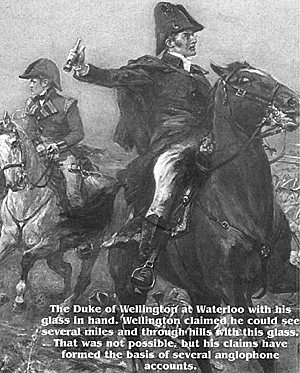
We will next establish Wellington's movements and what he could see from the Prussian headquarters. When Wellington rode from Quatre Bras to Brye, he is most likely to have taken the main road to Namur at then turned right up one of the side roads after les trois Burettes towards the windmill. In doing so, he would have passed three brigades and Reserve Cavalry of Pirch I's II Army Corps. These three brigades were drawn up on the reverse side of the hill between Ligny and Brye, out of sight and out of range of the French artillery. The Reserve Cavalry was even further to the rear. The regimental history of the Queen's Dragoons mentions,
'About one o'clock, the English supreme commander, the
Duke of Wellington, passed the positions of the II Corps on his way
to meet Blucher. The regiment was fortunate enough to see this
famous warlord from close up.' [5]
The Duke would have seen the II Army Corps deployed on
reverse slopes and out of range of the French artillery. He would then
have ridden through Pirch II's Brigade, on the windmill height and out
of effective range of the French artillery. From the windmill, looking
towards St. Amand, he would have seen the Prussian batteries drawn up
near the windmill in reserve. These were out of effective range of the
French artillery. The Prussian grand battery was deployed south-west
of the windmill. It was in effective range of some of the French artillery.
Conversely, some of the French artillery was in effective
range of the Prussian grand battery, so the Prussians were at no
particular disadvantage here. Six battalions of infantry were drawn up
in front of the grand battery, in a hollow. They were in effective
range of the French artillery, but being in dead ground and in tall
crops, the effectiveness of the French artillery fire must have been
reduced. On the ridge in front of this hollow, a further Prussian
battery was deployed. It was at maximum effective range from the
French artillery. As the French artillery was likely to be concentrating
its fire on the defenders of St. Amand, it is unlikely that this Prussian
battery would be at a great disadvantage here.
Three battalions of infantry were deployed in St. Amand.
One wonders if Wellington was in a position to distinguish them as
they were in cover. These men were in canister range of the French
artillery, but were in hard cover. Looking down towards Ligny, the
Duke would have seen two battalions of Henckel's Brigade, Zieten's
Reserve Cavalry and six battalions of Jagow's Brigade drawn up on the
slope behind Ligny. These men were within maximum effective range
of the French artillery deployed in front of Ligny.
As the French artillery was positioned to concentrate its fire
on the village of Ligny, the danger to these men was minimal. Any
overshoot was going to be up a steep slope, which would also minimise
the effect. Finally, the line of sight was restricted by the village,
making effective fire on these reserves difficult. In Ligny itself, there
were 4 1/2 battalions of infantry. These men were also in hard cover,
which lessened the effect of the French artillery fire. in and around
the village of Brye, close to the windmill, 3 1/2 battalions were
deployed, partly in cover, and all out of range and out of sight of the
French. These men were near enough to Wellington for the Duke to
have seen them. The III Army Corps was most probably out of sight
of Wellington and thus, for the purposes of this essay, we do not need
to consider its positions in detail.
Both Pirch I's and Zieten's Corps were each about 30,000
men strong. Wellington thus saw the positions of about 60,000
Prussians. We have already established that while riding to Blucher's
headquarters, he saw Pirch I's 30,000 men drawn up on a reverse
slope, out of the range of the French artillery. Of Zieten's Corps, 7 1/2
battalions, about 5,000 men, were in canister range. A further 15
battalions, 5 cavalry regiments and the grand battery, about 14,000
men in total, were within maximum effective range of the French
artillery. Thus, of the 60,000 Prussians Wellington could see, over
40,000, were either on reverse slopes, or out of range of the French
artillery or both. A further 14,000 were at maximum range and all the
men in close range were in cover.
More Were the Prussian Positions at Ligny Exposed
Introduction
The Sombreffe Position
Wellington and the Windmill at Bussy
De Ros
Stanhope
Ellesmere
Conclusions
Large Ligny Map (extremely slow: 472K)
Jumbo Ligny Map (monstously slow: 1.42Mb!)
Back to Age of Napoleon 30 Table of Contents
Back to Age of Napoleon List of Issues
Back to MagWeb Master List of Magazines
© Copyright 1999 by Partizan Press.
This article appears in MagWeb (Magazine Web) on the Internet World Wide Web.
Other military history articles and gaming articles are available at http://www.magweb.com